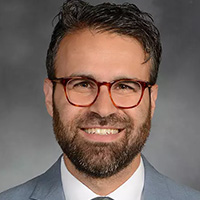
Dr. Russell Rosenblatt
Significant disparities plague both female and Black patients in need of a liver transplant for alcohol-associated liver disease (ALD), according to a new study led by Russell Rosenblatt, MD, MS, a transplant hepatologist at the Center for Liver Disease and Transplantation at NewYork-Presbyterian/Weill Cornell Medicine. The study is one of the first to assess the role that gender and race play before patients are placed on the transplant waiting list.
“In practice we see that patients who have fewer resources and are more vulnerable often don’t make the cut,” says Dr. Rosenblatt. “We wanted to find a way to study this. The biggest challenge was the way we conduct research as a field. We have this great database, which shows all patients who were ever listed for transplant and who went on to transplant, but it doesn’t show the steps that occurred before.”
To study inequities borne by patients prior to getting on the transplant waiting list, Dr. Rosenblatt developed a new metric—the listing-to-death ratio (LDR). It compares the number of patients who are listed for a liver transplant in a state versus the number of patients who die from liver disease. The lower the LDR in a particular population, the greater the existing disparity.
The growing burden of alcohol use disorder and alcohol-associated liver disease
Although previous research has documented disparities in liver transplants overall, disparities in liver transplants for ALD are less clear, Dr. Rosenblatt says. Decisions around organ transplantation in people with the condition are particularly fraught. Although there’s a growing acceptance of alcohol use disorder as a chronic disease, stigma still surrounds the diagnosis.
“We wanted to look at factors at play in determining who gets on the waiting list because we know that’s where subjective biases come in,” says Dr. Rosenblatt. “Once you introduce more potential subjectivity, biases can show themselves. Alcohol is that for liver disease. ALD is the most subjective disease we deal with in gauging eligibility for transplant.”
Dr. Alyson Kaplan
Questions about disparities have become more urgent as cases of ALD are rising. “Liver disease related to alcohol is growing exponentially in the U.S.,” says Alyson Kaplan, MD, a fellow in adult transplant hepatology at NewYork-Presbyterian/Weill Cornell Medicine and first author of this study. “The majority of the cases that we evaluate for transplant are due to alcohol use, and that problem was exacerbated by COVID. It’s very relevant to all of us practicing.”
Disparities are known to affect the allocation of livers to those in vulnerable groups on the waiting list. Women with ALD are less likely to receive a transplant, yet they are more susceptible to the disease at lower quantities of alcohol, are less likely to be treated for alcohol use disorder, and have increasingly higher rates of alcohol consumption, the authors write. Black patients are among those most susceptible to ALD and have lower survival rates after a transplant.
We wanted to look at factors at play in determining who gets on the waiting list because we know that’s where subjective biases come in. Once you introduce more potential subjectivity, biases can show themselves. Alcohol is that for liver disease. ALD is the most subjective disease we deal with in gauging eligibility for transplant.
— Dr. Russell Rosenblatt
Study details
Dr. Rosenblatt’s team analyzed patients ages 25 to 64 who were listed for liver transplantation and/or died from end-stage liver disease (ESLD) between 2014 to 2018 using two national databases: the Centers for Disease Control and Prevention’s Wide-ranging OnLine Data for Epidemiologic Research (CDC WONDER) and the United Network for Organ Sharing (UNOS). Patients with ALD were compared to non-ALD patients. The primary outcome was the LDR—the ratio of listings for liver transplants to deaths from ESLD—which assesses access to the waiting list.
The study showed there were 65,588 deaths and 16,133 listings for ALD patients compared with 75,020 deaths and 40,194 listings for patients with non-alcohol related liver disease. ALD patients had lower access to liver transplants than non-ALD patients, based on the LDR. And among those with ALD, female and Black patients were the least likely to be wait listed for liver transplantation.
Dr. Rosenblatt and his team faced several limitations, including not knowing the reasons patients were not placed on transplant waiting lists. Coding errors may also have weakened the strength of the findings.
Broadening access
However, Dr. Kaplan says the data is consistent with other evidence confirming the existence of inequities. “The next step in all disparities research is to focus on intervention work as opposed to just figuring out new ways to describe a phenomenon that we already know exists,” she says. “We need to figure out how to fix it.”
The next step in all disparities research is to focus on intervention work, as opposed to just figuring out new ways to describe a phenomenon that we already know exists. We need to figure out how to fix it.
— Dr. Alyson Kaplan
In that vein, Dr. Rosenblatt points to a collaborative effort among NewYork-Presbyterian, Weill Cornell Medicine, and Columbia transplant teams called the Black Liver Health Initiative, which involves training medical staff on how to identify and address implicit bias. Outreach into vulnerable communities with the goal of educating patients about the liver transplant process is also needed.
“Reaching those patients and getting the necessary follow-up is incredibly hard work,” says Dr. Rosenblatt. “To increase access to transplantation, we need to put forth more effort into understanding what other people are going through. There's been a very conscious rethinking in our system of how we see and approach these patients and a better understanding that certain people may need more resources.”





